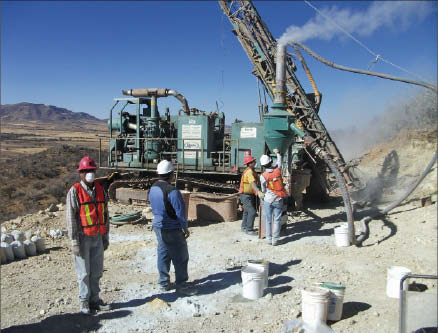Having one of the most heralded silver bulls in your corner doesn’t hurt when you’re looking to become the next significant silver miner in Mexico.
And that is just the set of circumstances that Oremex Resources (ORM-V) is armed with as it drives its Tejamen silver project in Mexico’s Durango state towards production.
The bull backing the firm is none other than Eric Sprott, as his Sprott Asset Management team is currently holding roughly 16% of Oremex’s outstanding shares.
Sprott’s position on silver has been well-outlined – he believes the above-surface supplies pale in comparison to the dollars that are eager to snatch them up – and he reckons the metal is due to break well out of a long consolidation pattern.
But with many silver explorers to choose from, why the faith in Oremex?
The first part of the answer is Tejamen; the company’s flagship project currently has 22.6 million tonnes grading 69.8 grams silver for 50.8 million oz. silver.
And considering that all those tonnes are in the inferred category, the deposit has plenty of room to grow.
That growth, however, is temporarily on hold as the Mexican government has yet to decide who will be granted the access rights to the property.
There are currently two groups vying for the rights, but Oremex’s chief financial officer Paul Haber says the company is not concerned with who wins the rights, it just wants the government to grant them so it can begin negotiations with that party.
Oremex, which already holds the mineral rights for the property, will look to get the drills turning as soon as the access rights are sorted out.
Along with exploration drilling, and infill drilling to upgrade inferred resources to the measured and indicated category, Oremex will also look to update the economic parameters of a future mine.
The economics of the project were outlined in 2006 in a report prepared by Snowden, which considered an open-pit, heap-leach operation that would produce
3.5 million to 4 million tonnes of silver a year at a cash cost of US$4 per oz. The mine would cost US$50 million to build and would have a 2-to-1 strip ratio.
While costs are expected to rise (due to the estimate being five years old), a silver price in the
mid-US$30 per oz. range, which
is where it sits now, would offer some comfortable margins.
Haber says it is Tejamen’s low-cost potential, combined with an experienced management team that has helped garner the interest of such heavyweight investors
like Sprott.
That management team is
led by Michael Smith, who has
built a sturdy reputation by heading Barrick Gold‘s (ABX-T, ABX-N) Mexican operations, and by being the former head of Continental Gold (CNL-T), which has been a market darling over the last year for outlining a large amount of
gold at its Colombian projects.
As for the exploration upside at the project, that will likely come from feeder veins beneath the two main deposits, Los Mantos and Cerro Prieto.
And while the prospectiveness of Tejamen is tantalizing, it certainly doesn’t compose the entire Oremex story going forward.
Indeed the company felt confident enough in its silver assets to shed two of its more prospective gold projects via a spin-out that was announced in early March.
While part of the motivation for the spin-out was that the company felt the projects’ values weren’t being reflected in its market cap, the prospect of building itself into a substantial silver pure play also proved alluring.
Interestingly, spinning out gold assets will involve splitting its San Lucas project down the middle.
That is because the property hosts both silver and gold mineralized zones in nearby but separate zones.
The project lies on strike with another polymetallic project, Silver Standard Resources‘ (SSO-T, SSRI-Q) San Agustin project in Durango, which has measured and indicated resources totaling 1.59 million oz. gold and 47.9 million oz. silver (based on 121 million tonnes grading 12.3 grams silver and 0.4 gram gold).
While San Lucas is not nearly as developed as its neighbour, the project has returned some stellar assays such as 14 metres of 158 grams silver, 16 metres of 81.7 grams silver and 12 metres of 145 grams silver.
Despite those results, Oremex is increasingly bullish on what had been the third priority project:
its Chalchihuites silver deposit in Zacatecas state.
The project is situated in a prolific silver-producing district as it is on strike and less than 4 km from First Majestic Silver‘s (AG-N) Del Toro project, which has 20.9 million oz. of silver in the measured and indicated category and 35.9 million oz. in the inferred.
Oremex describes the property as hosting a skarn and manto system with mineralization associated with shear zones hosted in a granodiorite stock and rhyolite dykes, and in limestone adjacent to the granodiorite stock.
The site hosted past production of high-grade silver-zinc-lead that saw grades of up to 3,800 grams silver and 0.99 gram gold.
With that kind of history, and strong early sampling results, the company says Chalchihuites has the potential to “quickly become our number two project in terms of importance.”
The results from that sampling program, released on March 21, returned highlight grades of 3,540 grams silver per tonne, 3.4 grams gold, 13.2% lead and 5.4% zinc.
While the sampling program was being done to identify drill targets, it also extended the silver-gold-lead-zinc mineralization on the property.
Drilling at Chalchihuites is expected to get underway in a few months, once the company has the necessary environmental permits.
While the company has just $1.7 million in the kitty, Haber says there are no imminent plans to raise capital.
As of late, the market has been catching up to the Oremex story. Oremex shares have climbed 87% since mid-February when they were trading for 23¢. In Toronto on March 24, shares closed at a
52-week high of 43¢


Be the first to comment on "Oremex built to ride the silver wave"